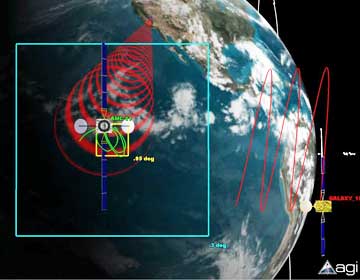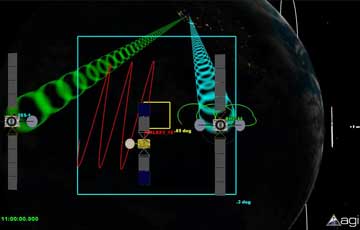
This rendering emulates the Galaxy- 15's current path which is a continual circle pattern, and the choreography-type plan of SES World Skies' to side-step the satellite.
Described here: "As the stray satellite nears AMC-11's orbital location at 131 degrees west, SES WORLD SKIES plans to have AMC-11 match the eastward drift of Galaxy 15 in order to maintain a minimum separation between the two satellites. This synchronized drift is designed to protect AMC-11 services from interference caused by Galaxy 15.
At the same time, SES WORLD SKIES will move its new SES-1 satellite to the opposite side of Galaxy 15, thereby enabling some customers, including cable television networks, to leapfrog their broadcasts over interference caused by the wandering spacecraft. Customers will either be able to maintain services on AMC-11 during its drift, or repoint antennas to SES-1 in order to best protect their services.
For those customers who will stay on AMC-11 throughout the mission, their television programming will be delivered over a large 19-meter antenna capable of minimizing potential disruptions. SES WORLD SKIES expects to initiate the synchronized eastwards drift of AMC-11 on May 25, and estimates that the risk of interference will end on June 7 when Galaxy 15 exits the area about 22,000 miles above the earth's surface.

The Galaxy 15 spacecraft will be 0.5 degrees west of AMC-11 on May 23rd and will be at AMC-11’s assigned orbital location of 131 west on May 31st (Memorial Day in the U.S.). Galaxy-15 will continue eastward and will pass 0.5 degrees east on June 7th.
There is no risk of a physical collision of the two spacecraft – contrary to suggestions is some press articles recently.
There is, however, the possibility of multi-path interference to AMC-11’s services caused by Galaxy-15 relaying off axis emissions from AMC-11 uplink antennas. In order to minimize or eliminate such interference several mitigation strategies will be deployed as follows:
- AMC-11 will be moved up to 0.3 degrees to the east and then relocated 0.3 degrees to the west of Galaxy 15 in order to maintain a minimum separation between the spacecraft for as long as possible. SES will also position a spare satellite to the west of Galaxy 15 to temporarily transfer some traffic to whilst AMC-11 is relocated west. This sequence of events will start to happen on or about May 23rd and will be completed on or about June 7th ;
- The sensitivity of the AMC-11 spacecraft has been temporarily adjusted so that AMC-11 is much more sensitive than Galaxy 15;
- Where possible, programming services will be moved to a very large uplink antenna capable of discriminating between AMC-11 and Galaxy 15 even when they are very close together.li>
SES WORLD SKIES believes that a combination of the 3 strategies above when applied to AMC-11’s services will minimize any interference to the vast majority of cable systems and more importantly will not require significant changes to ground receive equipment at cable operators’ facilities.

